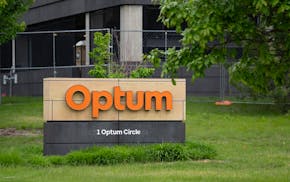Nobody wants a hearing aid unless they really need one. But Starkey Hearing Technologies hopes the fact that so many people walk around with earbuds can be parlayed into greater acceptance of the devices, which are now smaller, smarter and outfitted with AI technology.
For Starkey, the biggest U.S. hearing aid maker, increasing the size of the total market, as well as its share of it, is key. New technology and the addition of over-the-counter models has added strain to an already competitive industry.
Starkey had a sluggish 2022, as did the industry as a whole in the aftermath of the pandemic, CEO Brandon Sawalich said.
But now, buoyed by its AI-powered Genesis suite of devices, the company headquartered on 40 acres in Eden Prairie has mostly recovered, Sawalich said. Starkey's sales are up 8% to 10% this year, and data from the nonprofit Hearing Industries Association reported that hearing aid sales were up 10.5% in the third quarter.
The advantage of AI hearing aids is that they can recognize different listening environments — the office or your coffee shop — and make adjustments to deliver the clearest experience.
"We can train that signal processing. The patient has to do less work and the signal processing is doing more of the work," said Tom Powers, strategic adviser with the Hearing Industries Association.
While Starkey is not the only company with AI-powered products, the Genesis suite is making inroads for the company.
"It's been very well-received in the market," said Karl Strom, the Duluth-based editor of consumer website Hearing Tracker who has been reporting on the hearing industry for 30 years.
Sawalich took over as CEO of the company after his stepfather, founder Bill Austin, learned that several former C-suite members — who eventually pleaded guilty or were found guilty — were involved in embezzlement.
Sawalich then started rebuilding the company's leadership, including bringing in Chief Technology Officer Achin Bhowmik from Intel in 2017. The next year, the company started its quest to add AI to hearing aids.
Europe dominates the hearing aid market, with four of the "Big Five" industry leaders based there, three in Denmark alone. Starkey — which employs 6,000 in 29 manufacturing facilities, including 1,400 in Eden Prairie — is the only one based in the U.S.
In 2019, a global market overview from Germany-based Statista put Starkey fifth among the five, with 4% of global hearing aid sales.
Starkey disputes the rankings. The privately held company no longer discloses its revenue, but in 2015 had sales of more than $800 million. Industry rankings compiled by Yahoo Finance put its current revenue at more than $1 billion.
Starkey has a big footprint in the U.S. and is one of the main suppliers of the Department of Veterans Affairs system.
The already complicated hearing market became even more so a year ago when the Food and Drug Administration allowed over-the-counter hearing aids to enter the market.
Those do not have the same strict oversight as the prescription higher-end aids, but they were expected to turn the market upside down.
While the addition of OTCs has disrupted the hearing aid industry, it hasn't been as drastic as some experts predicted.
One reason is cost. OTCs can cost more than $1,000 a pair, Strom said. While Starkey prescription devices can cost $2,000 to $6,000, they also are covered by many insurance plans.
Millions covered under UnitedHealthcare plans, for example, including Medicare Advantage customers, can get prescription hearing aids for as little as $175, said Will Shanley, spokesman for the Minnetonka-based insurer.
For those whose insurance does not cover hearing aids, the OTC options have been touted as a cheaper, more widely available alternative. People can get them in stores like Walmart and Best Buy. According to FDA guidelines, OTC hearing aids are for people with mild to moderate hearing loss.
The FDA still recommends that patients with severe hearing loss get a prescription pair.
Sawalich, who wears aids in both ears, said some customers are coming to Starkey after buying and being frustrated by the quality of OTC hearing aids.
"We have people coming into our regional offices and they're mad," he said.
Still, Starkey does also make OTC devices through its Start Hearing subsidiary that sell for $899 a pair.
"We have options for our customers and patients," Sawalich said.
The average first-time user of a Starkey hearing aid is 67 years old.
About one in three Americans 65 to 74 years old and half of those 75 and older are hard of hearing, according to the National Institute on Deafness and Other Communication Disorders.
As populations get older, the $11.98 billion global hearing aid market is predicted to grow to $21.1 billion by 2030, according to Fortune Business Insights.
Yet a secondary market — especially if the industry can get past the stigma associated with hearing aids — is among young adults. The Centers for Disease Control and Prevention estimates that one in five Americans has hearing loss from noise damage by the time they are 30.
The technological advances made by Starkey and other companies can be fine-tuned to the market. For older users, they are programming in such features as sensors that can detect falls. For younger users, there is a noise-canceling option (similar to that in some earbuds) and even language translation.
But Sawalich wants customers to know that hearing aids are not simply cool little gizmos.
"Hearing is health care. It's not a consumer electronic," Sawalich said.
The Genesis AI aids, unveiled in February, required "all new everything," Sawalich said. From new software and design for the aids themselves to a new smartphone app and a longer-lasting lithium battery.
"Genesis AI is the flagship product in our industry," Sawalich said.
While not everyone is as enthusiastic, Brad Ingrao, a nationally recognized audiologist, recently recommended Starkey's AI devices over those of one of its biggest competitors, ReSound, in a review for Seniorliving.org.
Ingrao, official audiologist for the International Committee of Sports for the Deaf, gave both hearing aids good marks but noted one area where Starkey has an edge: "They also offer some of the industry's first hearing aids that feature health, wellness and safety features backed by AI technology. These features include fall detection, step tracking and daily brain activity reports."
The Twin Cities was once considered the world's hearing aid capital and home to numerous companies in the industry. The local Telex Corp. was making vacuum tube hearing aids in the 1930s. Kenneth Dahlberg, who had worked at Telex, founded Dahlberg Electronics in 1948. The company invented the Miracle-Ear hearing aid in 1955.
The Twin Cities "has been a real incubator for a lot of companies, a lot of technologies," said Powers, the Hearing Industries Association analyst.
Amplifon, an Italian global hearing aid retailer that bought Miracle-Ear in 1999, has its U.S. headquarters in downtown Minneapolis. The company employs 224 people in the Twin Cities area.
"Minnesota has a long history as an epicenter for business and, in particular, is the home to several health care innovators. There is tremendous value in being part of this type of community," said Alessandro Bonacina, executive vice president of Amplifon Americas, in a statement.
3M was once in the hearing aid business and sold those operations to ReSound in 1996.
And then there's Starkey.
"Bill Austin changed the industry," said David Preves, a retired engineer with hearing aid expertise who worked twice at Starkey and holds about 30 patents for components of hearing aid technology.
"It's still the best custom in-the-ear product," Preves said of Starkey's hearing aids.

Delta hiked fares for solo travelers, until Twin Cities travel experts caught the change

In first speech back, UnitedHealth's new CEO pledges to review hot-button issues

A child had measles at Mall of America, concerning state health officials who don't know source

Ramstad: Gov. Walz, things are not getting done in Minnesota

